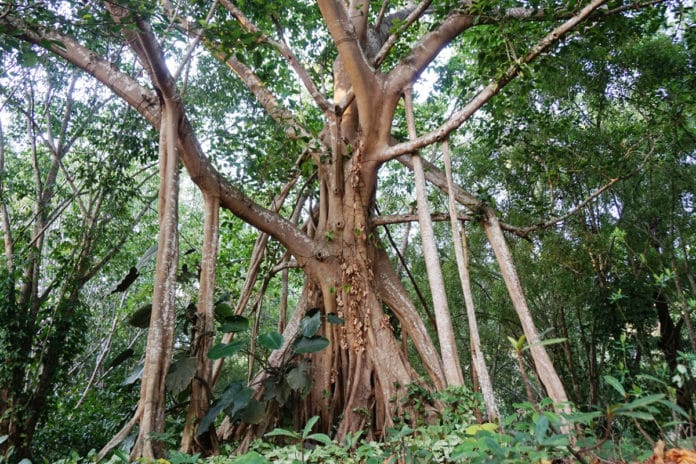Their extraordinary aerial roots distinguish banyan trees—one of its species Ficus genus that has evolved a species-specific mutualism system with wasp pollinators. Wasp is the only insect that can pollinate it.
In a new study, scientists distinguish regions of the banyan fig’s that advance its ability to signal its wasp pollinator.
Scientists also identified a sex-determining region in a related fig tree, Ficus hispida. Unlike F. microcarpa, which produces aerial roots and bears male and female flowers on the same tree, F. hispida has distinct male and female trees and no aerial roots.
Ray Ming, a plant biology professor at the University of Illinois, Urbana-Champaign who led the study with Jin Chen, of the Chinese Academy of Sciences, said, “Understanding the evolutionary history of Ficus species and their wasp pollinators is important because their ability to produce large fruits in a variety of habitats makes them a keystone species in most tropical forests. Figs are known to sustain at least 1,200 bird and mammal species. Fig trees were among the earliest domesticated crops and appeared as sacred symbols in Hinduism, Buddhism and other spiritual traditions.”
The relationship between figs and wasps likewise presents a fascinating scientific challenge. The body shapes and sizes of the wasps relate precisely to those of the fig fruits, and every type of fig delivers a unique perfume to attract its specific wasp pollinator.
Scientists examined the genome of two fig species, in addition to a wasp that pollinates the banyan tree. They wanted to understand these evolutionary developments better.
When they sequenced the trees’ genomes, they found more segmental duplications in the banyan tree’s genome than in F. hispida, the fig without the aerial roots. Those duplicated regions account for about 27% of the genome.
The duplications increased the quantity of genes associated with the synthesis and transport of auxins, a class of hormones that promote plant growth. The duplicated regions likewise contained qualities involved in plant immunity, nutrition, and the production of volatile organic compounds that signal pollinators.
Ming said, “The levels of auxin in the aerial roots are five times higher than in the leaves of trees with or without aerial roots. The elevated auxin levels appear to have triggered aerial root production. The duplicated regions also include genes that code for a light receptor that accelerates auxin production.”
The detailed analysis of the figure’s genome wasp, and its comparison with those of other related wasps revealed that the wasps retained and preserved genes for odorant receptors that detect the same smelly compounds the fig trees produce. These genomic signatures are a signal of coevolution between the fig trees and the wasps, the researchers report.
Scientists also discovered a Y chromosome-specific gene expressed only in male plants of F. hispida and three other fig species that produce separate male and female plants, a condition known as dioecy.
Ming said, “This gene had been duplicated twice in the dioecious genomes, giving the plants three copies of the gene. But Ficus species that have male and female flowers together on one plant have only one copy of this gene. This strongly suggests that this gene is a dominant factor affecting sex determination.”
Journal Reference:
- Xingtan Zhang et al. Genomes of the Banyan Tree and Pollinator Wasp Provide Insights into Fig-Wasp Coevolution. DOI: 10.1016/j.cell.2020.09.043
